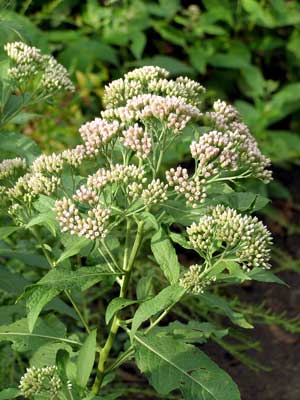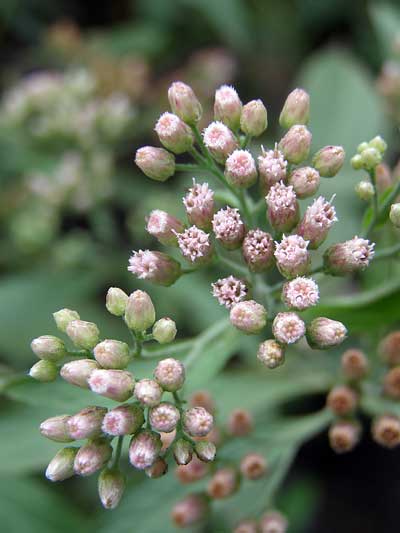After Joe-Pye

PHOTO BY KEN MOORE. Wild camphorweed makes a nice deer-resistant garden plant.
Flora Columnist
“After Joe-Pye weed comes Pluchea.â€
That was the declaration from gardening friend Sally several weeks ago when Joe-Pye weed flowering heads of purple gave way to seed heads of shades of brown.
Joe-Pye, commonly seen standing tall in wet meadows and roadside ditches, is familiar to many of us, but not so with the shorter flowering stems of marsh fleabane, Pluchea camphorata. In fact, unless it is accidentally touched, creating an unforgettable smelling experience, one most likely will never have acknowledged it.
I know this plant by the common name, camphorweed. And because of the distinctive aroma of crushed flower heads, that’s the name I prefer. Upon my first encounter smelling the plant, I was impressed, but not favorably. However, like a number of so-called “connoisseur†things – vintage cigars, Scottish single malts and some of the sophisticated teas – camphorweed is something for which you could eventually acquire an affinity.
Now whenever I find camphorweed in wet ditches or along riverbanks, I reach over to crush some of the flower heads and look forward to getting a whiff of its tell-tale odor. Neophytes will undoubtedly describe it as pungent and unpleasant. However you respond, you won’t forget the experience.
Though common throughout the coastal plain and the Piedmont, the delicate pink flower heads don’t jump out at you. Camphorweed generally stands no higher than accompanying goldenrods and Eupatoriums and other common companions, and is easily missed when viewing the general mix of plants in ditches and along streams.
Sally’s declaration about Pluchea results from her experience of growing it in a garden setting, where single plants become attractive specimens, such as the ones she tends in the Garden of Flowering Plant Families behind the Totten Center of the N.C. Botanical Garden. That’s probably the only garden in which you will find distinguished camphorweed.
It is capable of getting around via those delicate flying seeds, characteristic of most members of the composite or aster family. If you pause and observe the several ditches and swales near the Botanical Garden’s new visitor center, you will find some handsome specimens of camphorweed in the assemblage there of other interesting moisture-loving plants, including boneset, several engaging sedges and even cattails. All those plants “planted†themselves from specimens elsewhere in the gardens. It’s always interesting to appreciate how nature designs gardens in available spaces.
Take a closer look at those tubular (disc) flowers of camphorweed. Do you recognize those star-shaped disc flower openings? You’ve seen similar ones in recent Flora stories of other composite family flowers.
I am surprised that camphorweed, with such a pungent aroma, does not have an impressive heritage of medicinal or other practical uses. The common name, marsh fleabane, suggests that some folks may have used crushed plants as a natural insect repellent.
A significant attribute pointed out by Sally is that deer don’t like it, so it is desirable as a garden plant. Make note that Sally has potted up some seedlings for the garden’s special fall plant sale, Saturday, Sept. 25. That may be your only opportunity to add this deer-resistant plant to your garden.
At least go by and pay it a visit, and don’t hesitate to gently crush the plant for that special odiferous experience.
Email Ken Moore at flora@carrborocitizen.com.

PHOTO BY KEN MOORE. Tiny camphorweed heads of disc flowers pack a powerful odor.


Comments are closed.